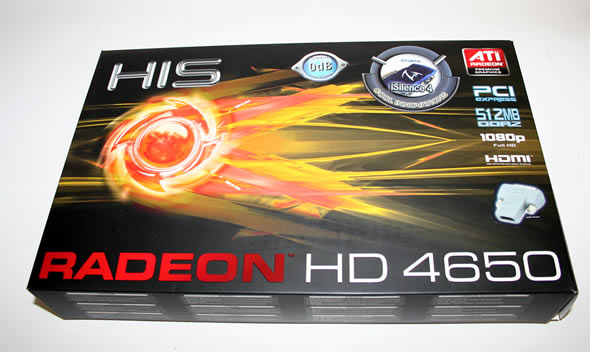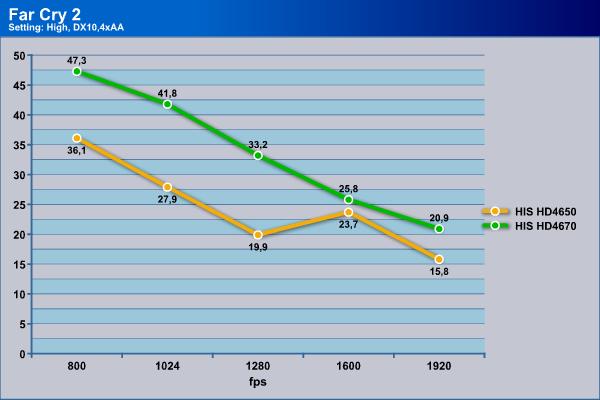The HIS HD 4650 iSilence 4 512MB is a passively cooled video card where HIS has combined the HD4650 GPU with a Zalman cooler. We have put the card through its paces to see what kind of performance you can expect for $80.
INTRODUCTION
HIS is a company known for their various AMD-based video cards, especially those with the excellent IceQ-cooler. We have reviewed a lot of their cards here at Bjorn3d.com and overall, we’ve been very impressed with their quality and performance.
One of their popular line of cards has been the cards using the various IceQ-coolers from Artic Cooling. While the IceQ-coolers are really silent even when the cards are running at maximum performance, they still emit a bit of sound, enough to annoy those who want a totally silent system. The solution, of course, is to make the card passive cooled, and HIS also offers a few passively cooled cards where they have partnered up with Zalman and put a Zalman VNF100 on the cards to cool them passively. So far they have only done this to an HD2600XT card and an HD3650 card and it is therefore no surprise that they have chosen an HD4650 GPU from this generation.
The card is called the HIS HD 4650 iSilence 4 512MB and we have been taking the card for an extended spin in our testing lab to see how good is.

FEATURES AND SPECIFICATIONS
The GPU that HIS has chosen for their first passively cooled solution is the HD4650. This is a not an enthusiast-GPU. Instead, it is aimed at the mainstream users. Together with the Zalman VNF100, it, however, also looks like a perfect candidate for a slightly more powerful HTPC-card.
- 320 stream processing units
- 128-bit memory interface
- 24x custom filter anti-aliasing (CFAA) and high performance anisotropic filtering
- PCI Express® 2.0 support
- Dual mode ATI CrossFireXTM multi-GPU support for highly scalable performance
- High-speed 128-bit HDR (High Dynamic Range) rendering
- ATI AvivoTM HD video and display technology
- Built-in HDMI with 7.1 surround sound support
- Support for the ATI RadeonTM DVI to HDMI adapter
- Unified Video Decoder (UVD) for Blu-rayTM and HD DVD
- Dynamic geometry acceleration
- Game physics processing capability
Let us look what the difference is between the HD4650 and the closest other video card, the HD4670.
|
Feature/Specification |
HIS HD4670 |
HIS HD4650 |
|
GPU
|
HD4670
|
HD4650
|
|
Stream Processor
|
320
|
320
|
|
Core Clock
|
750
|
600
|
|
Memory Clock
|
1746
|
800
|
|
Memory Size
|
1024
|
512
|
|
Memory Type
|
DDR3
|
DDR2
|
|
Memory Interface
|
128 bit
|
128 bit
|
The main difference, in addition to slightly a slightly different clocked core, is the memory. The HIS HD4650 comes with DDR2-memory while the HIS HD4670 comes with DD3-memory. This gives the HD4670 a clear advantage in memory bandwidth. It will be interesting to see how that translates in performance.
As mentioned in the beginning, it also features the Zalman VNF100 VGA-cooler. This cooler has three high performance heatpipes to provide maximized heat transfer. It comes with thin aluminum fins which makes sure it is not too heavy for the video card.
CLOSER LOOK
The card comes in a regular HIS-box with nothing more than the card, a few adaptors and a driver-CD in it.
We do miss the excellent tool that HIS includes with many of their other cards.

The most prominent feature of the card is, of course, the Zalman-cooler. On the front of the card we see the huge blue cooler with Zalman’s logo. The cooler is not that thick, so the card should work in CrossfireX if you would like it to.
The three heatpipes extend from the front of the card to the back of the card.
On the back of the card we find the only indication that this is an HIS-card, as they put their logo on the smaller heatsink.
The card comes with two DVI-D connectors plus the obligatory S-Video-connector. HDMI-is handled with the included adapter.
SYSTEM & METHODOLOGY
The video cards were tested in the following system:
|
Feature/Specification |
Videocard1 |
|
CPU
|
AMD Phenom 8650
|
|
Motherboard
|
GA-MA78GM-DS2HP
|
|
Ram
|
2 GB Corsair DDR2@800MHz
|
|
CPU Cooler
|
AMD standard cooler
|
|
Hard drive
|
Samsung HD753-LC
|
|
Optical Drive
|
LG combined Blu-ray and HD-DVD drive
|
|
GPU’s tested
|
HD 4550
HIS HD4650 HIS HD4650
|
Synthetic Benchmarks, Games & Software
|
Synthetic Benchmarks, Games & Software |
|
3DMark06 |
|
3DMark Vantage |
|
Crysis Warhead |
|
World in Conflict |
|
Far Cry 2 |
|
PowerDVD 8 Ultra |
PERFORMANCE
3DMark06 V. 1.1.0
As expected, the HD4650 places itself between the HD4550 and the HD4670.
3DMark Vantage
For complete information on 3DMark Vantage Please follow this Link: www.futuremark.com/benchmarks/3dmarkvantage/features/
The newest video benchmark from the gang at Futuremark. This utility is still a synthetic benchmark, but one that more closely reflects real world gaming performance. While it is not a perfect replacement for actual game benchmarks, it has its uses. We tested our cards at the ‘Performance’ setting.
In both Futuremark products, the HD4650 places itself between the HD4670 and the HD4550.
Crysis: Warhead
This game demands the most of your computer and that shows in our results. The game actually is CPU-bound at around 24 fps since that is what the faster cards like the HD4870 gets on our system at the higher resolutions. So, while the HD4670 does not loose too many frames, when we increase the resolution, the HD4650 starts to show that it already has problems at 1024×768.
World in Conflict Demo
In World in Conflict the HD4650 already starts dropping off at 1280×1024.
Far Cry 2
Even though the HD4670 easily beats the HD4650, the HIS HD4650 actually performs really well at the Medium quality setting and DX9. ~40 fps at 1280×1024 is not bad for this type of card.
When we add 4xAA and increase the quality level to high, the HD4650 really takes a beating and it is simply not feasable to play the game with these settings.
Something interesting happens when we switch over to DX10 from DX9. At the lower resolutions we see an ~20% increase in performance, making it feasable to play the game at least at 800×600 and possibly 1024×768. We see a strange spike at 1600×1200 and verified it by running the benchmark a few times, so we are not sure what is going on there. Still, at around 20-25 fps, the game isn’t really playable at the higher resolutions.
MEDIA PLAYBACK AND POWER CONSUMPTION
We took three Blu-ray movies and measured the CPU-load while we were playing a 2-minute segment for each movie with PowerDVD 8 Ultra (with all the latest patches).
- Blade Runner, Blu-ray, VC-1, 1:42–1:44 minutes
- Pirates of the Carribbean: Curse of the Black Pearl, Blu-ray, MPEG4-AVC, 0:12–0:14 minutes
- Resident Evil 3: Extinction, 0:19 – 0:21 minutes
In Resident Evil 3 we turned on the Picture-in-Picture feature to see how the cards handle multiple HD-streams.
There is not much difference between the two cards. The two “regular” Blu-ray movies play fine and the CPU only has a load at around 15-20%, which is pretty impressive. When we turn on the second HD-stream it jumps up to around 40%, which still is impressive, considering we are pumping out two separate HD-streams that have to be decoded.
The power consumption is measured at the wall and thus is for the complete system excluding the monitor. The HIS HD4650 really performs well here and the complete system just draws around 88W at idle and 144W when running 3Dmark, which puts the load on the video card. That is especially impressive compared the the 189W that the HIS HD4650 draws.
Temperatures
As this is a fanless cooling solution, there might be fears that the temperatures of the card will be high. We measured the temperature with RivaTuner, both when the system was idle at the Windows desktop and while running 3DMark Vantage and got these results:
- Idle: 47°C
-
3DMarkV: 59°C
These temperatures are far from high and it seems the HD4650-GPU is a good choice together with the Zalman-cooler.
CONCLUSION

The gaming performance of the card is adequate and we actually were a bit surprised that it did performs as well as it did in Far Cry 2, a brand new game. This means that the card certainly can be used for gaming as long as you turn down the quality levels a bit.
Last but not least, the card excels in media playback. The HD3650 was the card of choice for many HTPC’s last year and we are quite certain that the HD4650 will be as popular. With its passive cooling solution, the HIS HD 4650 iSilence 4 512MB is even more suited for an HTPC.
Pros:
+ Runs cool
+ Decent gaming performance for its price
+ Completely silent
+ Low price
+ Excellent HTPC capabilities
Cons:
– Not suited for heavy gaming
– No bundle to speak of
– Even though it is cheap it costs about ~20$ more than a regular HD4650
HIS HD 4650 iSilence 4 512MB will receive a score of 8.0 (very good) out of 10.
 Bjorn3D.com Bjorn3d.com – Satisfying Your Daily Tech Cravings Since 1996
Bjorn3D.com Bjorn3d.com – Satisfying Your Daily Tech Cravings Since 1996





















